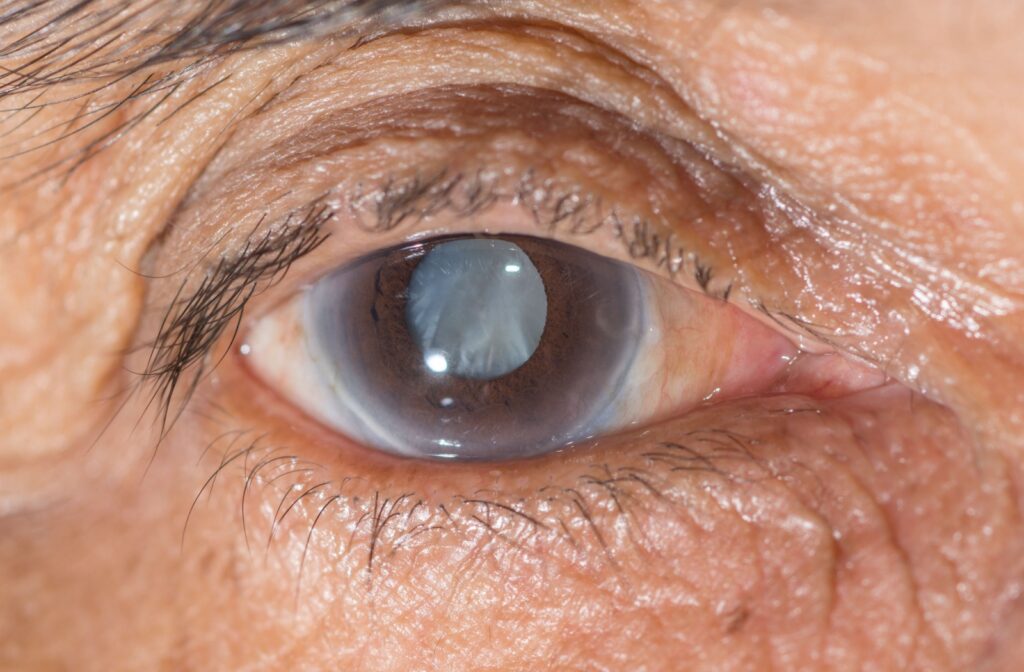Cataracts are a common age-related condition that gradually clouds the eye’s natural lens, leading to blurry vision, sensitivity to light, and difficulty seeing at night. Many people wonder: Is there a way to treat cataracts without surgery?
The short answer is: no, cataracts can’t be reversed or cured without surgery. However, if your symptoms are mild, there are ways to manage them before surgery becomes necessary.
What Are Cataracts?
Cataracts form when proteins in the lens of your eye break down and clump together, making vision cloudy. This process happens gradually and can impact your ability to read, drive, or recognize faces. While aging is the main cause, smoking, sun exposure, diabetes, and even some medications can contribute.
Common symptoms of cataracts include:
- Cloudy or blurry vision
- Increased glare or sensitivity to light
- Difficulty seeing at night
- Halos around lights
- Frequent prescription changes
- Faded or yellowed colours
Cataracts are a progressive condition, which means they worsen over time if not treated. If you’re noticing any of these symptoms, it’s a good idea to schedule an eye exam. Your optometrist can assess the severity of the cataracts and help guide your next steps.
Can Cataracts Be Treated Without Surgery?
Currently, the only way to effectively treat cataracts is with surgery. This procedure involves replacing the cloudy lens with a clear artificial one, and it’s one of the most commonly performed—and successful—surgeries in the world.
Still, if cataracts haven’t begun to significantly interfere with your daily activities, there are temporary, non-surgical strategies that can help you manage your vision.
Non-Surgical Ways to Manage Cataracts
While cataracts can’t be reversed without surgery, there are practical ways to manage symptoms in the early stages. These non-surgical options can help you maintain your visual comfort and daily routine until surgery becomes necessary:
Updating Your Eyeglass Prescription
As cataracts develop, your vision may change more frequently. Getting a new prescription for glasses or contact lenses can help sharpen your vision temporarily, making tasks like reading, driving, or watching TV more manageable. Although this won’t stop the cataract from progressing, it can delay the need for surgery.
Using Brighter Lighting
Cataracts reduce your eye’s ability to focus in low light. Increasing brightness at home and work, especially in reading or task areas, can reduce strain and help you see better. Consider daylight-spectrum LED bulbs, adjustable desk lamps, and under-cabinet lighting to enhance visibility.
Wear UV-Protective & Anti-Glare Eyewear
Exposure to UV rays can accelerate cataract progression. Wearing sunglasses with 100% UVA/UVB protection when outdoors helps protect your eyes. Indoors or while driving at night, anti-reflective or blue-light-filtering lenses can help reduce glare and light sensitivity.
Adopt a Healthy Lifestyle
Lifestyle choices can play a role in slowing cataract development. Quitting smoking, controlling diabetes, and eating a diet rich in antioxidants (such as leafy greens, citrus fruits, and fish high in omega-3s) can help protect your eye health. Regular exercise and staying hydrated may also support better overall eye function.
Use Magnifying Tools & Digital Aids
When fine detail becomes harder to see, tools like handheld magnifiers, large-print books, and digital devices with zoom features can make reading and other activities easier. There are also smartphone apps and settings that allow you to enlarge text or activate voice commands, reducing reliance on visual cues.
These strategies won’t cure cataracts, but they can make a meaningful difference in your quality of life while you’re deciding on the right time for surgery.

The Case for Cataracts Surgery
If the idea of surgery makes you nervous, you’re not alone—but cataract surgery is widely considered safe, fast, and highly effective. During the procedure, the cloudy lens is gently removed and replaced with a clear intraocular lens (IOL). Many people notice significantly improved vision within days.
Benefits of cataract surgery include:
- Restored sharp, clear vision
- Reduced glare and improved night vision
- Greater independence and quality of life
- The option to correct other vision issues (like astigmatism or nearsightedness) with premium IOLs
This outpatient procedure is typically completed in less than 30 minutes per eye, with a short recovery period and minimal discomfort. Most people return to normal activities within a few days.
When Should You Have Cataract Surgery?
The timing is different for everyone. If glasses and other adjustments are no longer helping, and your vision is affecting your ability to drive, work, or enjoy hobbies, it may be time to move forward with surgery.
Your optometrist can assess how cataracts are impacting your daily life and help you make an informed decision based on your needs, lifestyle, and overall eye health.
Supporting Your Vision at Pinehouse Eyecare
Although cataracts can’t be cured without surgery, early diagnosis and symptom management can help you stay comfortable and confident while planning your next steps. At Pinehouse Eyecare, we’re here to support you. Whether you’re exploring non-surgical options, preparing for cataract surgery, or simply keeping an eye on your long-term vision health.
Book an eye exam today and let our team help you take the next step toward clearer, more comfortable vision.










